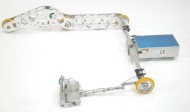 Kevin Dare – Managing Director, Face Consultants Ltd.
Kevin Dare – Managing Director, Face Consultants Ltd.
Face Consultants (Face) are now able to offer floor surveys to the recently introduced VDMA guidelines with the introduction of the Face ‘Fx’-meter as an attachment to its current Face Digital DIN 15185 Profileograph. This now enhances the family of Face Digital floor surveying equipment which already covers TR34 (FM and DM), The American F number system (including F min), EN 15620, DIN 18202 and Din 15185.
Face will be displaying their new FACE All-In-One Digital Profileograph, which includes the Fx Meter attachment, at the CoGri Group’s stand G03/1 in Hall 25 between 2nd – 6th May at CeMAT 2011 Hannover Germany.
Although Face can now survey the VDMA guidelines they do not currently endorse the recommendations as they have yet to be validated and peer reviewed.
In 2009 / 2010 Federation Européenne de la Manutention (FEM) drafted a guidance document (FEM 4.007) with recommendations for surface regularity which was based on the DIN 15185 specification but introduced a very small short wavelength control called ‘‘Fx’’. These recommendations were presented to the BITA – WITI Working Group (WG) on 14th July 2010 by members of the FEM Working Group 4. It was the decision of the BITA WG that it could not approve the FEM guidance note in totality and that further validation was required. Shortly after this meeting the FEM WG decided that the FEM 4.007 guidance note be removed from the table and the working group closed.
In September 2010 VDMA introduced a guideline “Floors for use with VNA Trucks” which is a slightly amended version of the FEM Guidance note rejected by FEM a few months earlier.
Face, with the assistance of BITA and their members, have started carrying out a number of surveys on existing installations where Very Narrow Aisle (VNA) trucks are operating at differing levels of performance. Each of the floors will be surveyed to TR34, EN 15620 and DIN 15185 as well as the VDMA Guidelines. Face are hoping that this study will help either validate the VDMA Guidelines or put forward recommendations from its findings. The result of this study will be available in May.
Constructing, testing and grinding floors to a standard of flatness to ensure a degree of performance is not new and floor flatness specifications to control surface regularity for VNA, defined forklift traffic has been around since the late 1970’s with the introduction of the ACI – F number system and in particular the F min numbers for VNA applications.
In the late 1980’s the UK took a slightly different approach with the introduction of a floor flatness standard in The Concrete Society’s Technical Report No. 34. (TR34). The terms; Superflat, Category 1 and Category 2 were born.
The DIN 15185 standard was developed specifically for VNA applications in the early 1990’s from the general building tolerances standard DIN 18202.
 In the third edition of TR34, a new surface regularity specification was introduced which looked at the floor profile as the truck actually saw it and based on the same principles of measurement used in the USA. This new specification is found in Appendix C of TR34.
In the third edition of TR34, a new surface regularity specification was introduced which looked at the floor profile as the truck actually saw it and based on the same principles of measurement used in the USA. This new specification is found in Appendix C of TR34.
In 2008 EN 15620 “Steel static storage systems – Adjustable pallet racking – Tolerances, deformations and clearances” was developed which included a surface regularity standard for floors with VNA applications. This European Norm is tested using the same principles as TR34 Appendix C recommendations with some slight modifications to the limits.
To read the full report on ‘Face Fact on VDMA’, please visit www.face-consultants.com
Face Consultants Ltd
Tel: 01484 600090




Comments are closed.